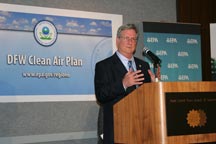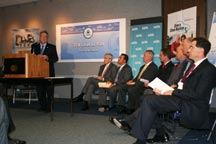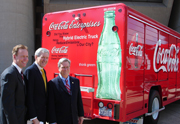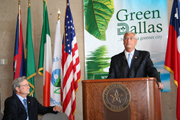Richard
Greene
Regional
Administrator - EPA Region 6
Richard
Greene's Biography
400-Day
Plan
Region 6 400-Day Plan
Our 400-Day Plan identifies our most important Regional objectives, and serves as a road map to outline how we will achieve those objectives by the end of the year. Having built in a 90-day review process, we are able to use this document as a tool to assess our progress and, when needed, adjust our plans.
 Regional Administrator hosts forum with key state officials to discuss climate change Regional Administrator hosts forum with key state officials to discuss climate change
Regional Administrator Richard Greene welcomed over 30 state officials and representatives from Texas, Oklahoma, Louisiana, New Mexico and Arkansas to the first regional dialogue on climate change.
 Senior representatives from each state’s environmental agency took part in the roundtable discussions, and shared their climate change strategies and suggestions with EPA leadership and other states.
Attendees also heard technical presentations about current state initiatives and programs addressing greenhouse gas and cleaner energy solutions. In addition representatives from the British Consulate-General shared lessons learned from the United Kingdom’s climate change policies. Senior representatives from each state’s environmental agency took part in the roundtable discussions, and shared their climate change strategies and suggestions with EPA leadership and other states.
Attendees also heard technical presentations about current state initiatives and programs addressing greenhouse gas and cleaner energy solutions. In addition representatives from the British Consulate-General shared lessons learned from the United Kingdom’s climate change policies.
The first-of-its-kind forum is part of the regional Clean Energy and Climate Change strategy that calls for expanding partnerships to tackle the factors that contribute to climate change. The forum’s main goals were to familiarize participants with state and federal perspectives; better understand individual and mutual concerns; and identify follow-up needs. Over the next 16 months EPA will be working closely with participants to develop opportunities for regional cooperation.
Dallas-Fort Worth clean air plan first in country proposed for EPA approval
 Texas Commission on Environmental Quality Chairman Buddy Garcia and Regional Administrator Richard Greene joined with community leaders and businesses within the nine county non-attainment area to strengthen the original plan. Texas Commission on Environmental Quality Chairman Buddy Garcia and Regional Administrator Richard Greene joined with community leaders and businesses within the nine county non-attainment area to strengthen the original plan.
Under the proposed plan, ozone forming pollutants will be reduced by 88 tons per day – about 40 tons more than the plan had first proposed.
“That work – a result of the North Texas can-do spirit – has moved this clean air plan across the goal line and makes it the first in the nation to gain EPA’s proposal for approval,” Greene said.
Of note is the North Texas effort to capture more dollars from the popular Texas Emission Reduction Plan, known as TERP, last spring. In the last six months, the DFW area beat out all other areas, two to one, with a record setting $84 million in applications from the $110 million grant budget. AirCheckTexas brought another $21 million to North Texas to repair and replace older vehicles which typically produce more emissions than newer models.
 Working with the NTCOG, Dallas-Fort Worth Airport and Love Field joined the campaign for clean air by refining estimates of their operations’ pollution emissions. New accurate information allowed EPA and Texas air quality modeling experts to certify pollution reductions totaling almost 10 tons per day. Working with the NTCOG, Dallas-Fort Worth Airport and Love Field joined the campaign for clean air by refining estimates of their operations’ pollution emissions. New accurate information allowed EPA and Texas air quality modeling experts to certify pollution reductions totaling almost 10 tons per day.
North Texas is also leading the nation to reduce pollution from power plants in the nine county non-attainment area. All are subject to the strictest air pollution controls required for either commercial or municipal power plants in the country. Texas also committed to restrict the amount of pollution credits, technically referred to as Discrete Emission Reduction Credits or DERCs, cutting pollution by 17 tons a day.
New regulations on back-up generators used by business and industry provided for some air quality improvements, about one ton per day. Other measures improved information used by EPA modeling experts in evaluating the plan. Better inventories of gas compressors showed their wide-spread use and resulted in an increase of three tons per day. New regulations adopted to control emissions from gas compressor engines will further improve air quality in the region.
“Our goal from day one was to encourage everyone to join an effort to bring clean air to the Dallas-Fort Worth area sooner than expected,” said Greene. “Had the SIP not been approvable, it would have resulted in years-long delays in getting the types of pollutant controls now being put in place.”
 Coke helps reduce pollution with hybrid vehicles Coke helps reduce pollution with hybrid vehicles Every business can become more environmentally friendly, as the Coca-Cola Bottling Company of North Texas has proven with the addition of 12 hybrid gas-electric vehicles to their distribution fleet. By using 32 percent less gas than traditional vehicles, the nine trucks and three cars will produce less polluting emissions and contribute to cleaner air in North Texas.
“Coca-Cola has shown that every company can find ways to help the environment,” said EPA Regional Administrator Richard E. Greene at a recent ceremony unveiling the vehicles. “This decision will also lead to savings in fuel costs, proving once again that what’s good for the environment is also good for business.”
Also attending the ceremony were Dallas Mayor Tom Leppert and Rick Gillis, vice president and general manager of Coca-Cola’s Southwest Business Unit. Mayor Leppert praised the company for leading the way as corporate good citizens by working to control their emissions.
Coca-Cola Enterprises’ Corporate Responsibility and Sustainability division is also developing ways to reduce the company’s water consumption, use sustainable and recyclable materials in all packaging, and reduce carbon emissions.
 EPA Administrator recognizes Dallas as model EPA Administrator recognizes Dallas as model
EPA Administrator Stephen Johnson and Regional Administrator Richard Greene joined city leaders in recognizing the City of Dallas for its city-wide commitment to pursue environmental excellence. Dallas, the ninth largest city in the United States, went beyond expectations while implementing its Environmental Management System (EMS) as an environmental stewardship tool. The City achieved the prestigious International Organization for Standardization ISO 14001 certification, the international “gold standard” for EMS certification.
To earn an ISO 14001 certification, organizations must use a strict environmental management system, monitor and continually improve their performance. The ISO 14001 standard encompasses all environmental areas, including energy use, water treatment, waste disposal, and noise and air quality. To maintain an active certification, entities must renew their certification every three years. Several cities throughout the United States have incorporated an EMS to assist with environmental issues, but none have achieved the concept on such a broad scale as the City of Dallas. Its EMS covers all 11 municipal departments and each of its nearly 13,000 employees.
“Going Green” for the City of Dallas began in the 1990s, when it converted its municipal vehicles to an environmentally friendly fleet operating on biodiesel and batteries. As a result, it not only improved the environment, but saved significant taxpayer dollars. The Jack Evans Police Headquarters, another environmentally friendly project, was the city’s first Leadership in Energy and Environmental Design (LEED)-certified structure.
Today, the City of Dallas has a fleet of nearly 1,100 environmentally friendly vehicles in its motor pool and more than 30 LEED-certified facilities including libraries, police and fire stations, cultural centers, recreation centers and service centers.
LEED certification information
ISO 14001 standards 
Press Release
Previous 300-Day Plan Accomplishments
Our 300-Day Plan Accomplishments (4 pp, 75K, About PDF) report tracks how the Region did in meeting the goals of our previous strategic plan.
 Helping
Communities It has been correctly observed that progress toward the goal of environmental improvement depends largely on work at the local level. We at EPA are committed to strengthening the relationship between urban development and environmental renewal.By improving the environment, communities become stronger economically and more desirable places to live and work.We are enthusiastic about the programs
described in our new brochure, Helping Communities, because they work for communities. Results confirm the benefits of actively pursuing innovation and voluntary initiatives.Our dedication to building partnerships through collaboration is making a positive difference in the quality of life. Our team is ready to help communities explore all the possibilities.
(2 pp, 190K, About PDF)
Note:
PDF files require the use of the free Adobe
Acrobat Reader. |